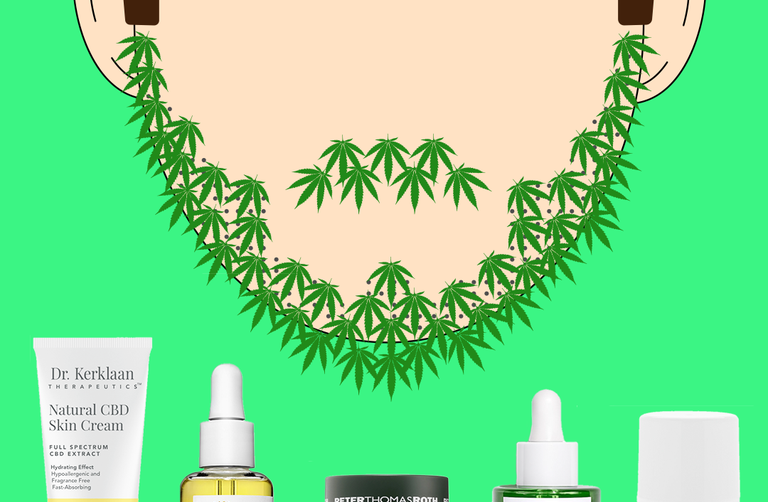I don’t remember when it happened exactly, but at some point my medicine cabinet started to look like a dispensary. All the products somehow now have cannabis leaves printed on the bottles and some even leave my bathroom smelling vaguely like a Phish concert. It’s because they all contain CBD, the buzziest ingredient in wellness—and now grooming.
If you haven’t heard of CBD, I invite you to come out from under your rock and join us in 2019. The ingredient is a derivative of the cannabis plant—“CBD” is a shortened, layman’s term for the fancier-sounding “cannabidiol”—and is being touted as a magical remedy for a laundry list of ailments including inflammation, insomnia, gastrointestinal distress, anxiety, and even epilepsy. (But it won’t get you high; sorry, brah.) It’s so common that it’s next to impossible to find a product that doesn’t contain CBD no matter where you shop: everywhere from Sephora to Whole Foods to CVS is getting in on the green wave.
But how this translates to your grooming routine is a little more nebulous, so I called up dermatologist Tony Nakhla, MD, to find out exactly why I’ve been slathering it all over my face—and if it really makes a difference.
First, What Is CBD Exactly?
Like the name sounds, CBD is a chemical compound found in the cannabis plant, just like its trippier cousin THC (the compound that gets you high). “CBD stands for cannabidiol, which is basically a chemical that interacts with what are called cannabinoid receptors in our body,” says Dr. Nakhla. “Those receptors are found mainly in the brain and in the central nervous system.” This ability to interact with our nervous system is what links CBD closely to pain management (more on that later).
Are CBD and Hemp Oil The Same Thing?
If you go by just the product labels, then you might assume they are. But you’d be wrong. “Hemp oil is the extract of the seed, and contains little to almost no CBD,” says Dr. Nakhla. “CBD, on the other hand, is a true extract from the whole plant.” That means, while hemp oil does have certain benefits, like a high concentration of fatty acids and vitamins, it doesn’t have the same effect on nerves that CBD does.
What Does It Do?
The better question is what doesn’t it do, at least if you trust the marketing machine. According to Dr. Nakhla, its true the implications are seemingly endless, but really only when it comes to the chemical’s ability to affect our nervous system. CBD’s effects are being studied in relation to mood, appetite, tumor suppression, seizure control, insomnia, and especially pain management. Basically, if an ailment has anything to do with nerves (even peripherally), there is someone somewhere who says CBD can help. That’s what contributes to our current idea that CBD is some sort of magical, catch-all remedy. Still, it’s hard to imagine things like CBD-laced mascara and hair products really making much of a difference to your overall wellbeing.
But Why Is It in My Moisturizer?
If you’re expecting to cure your insomnia by slathering CBD cream on your face, then you’re in for a sleepless night. But it does have other benefits when used topically, particularly on your face. “CBD has a calming effect or an anti-inflammatory effect on the skin,” says Dr. Nakhla. “It was found to reduce free radicals and help with the reduction of things like sun-induced aging. A couple of studies have shown that it also reduces oil production, so people who get clogged pores and acne can benefit from topical CBD.”
The thing to keep in mind if you’re using CBD to control breakouts, however, is that it’s typically stabilized in an oil-based product, so adding more oil (even a good oil) to your face might not necessarily be the best thing.
Okay, I’ve Bought a CBD Product. How Do I Know If It’s Good?
A warning from Dr. Nakhla: “If you’re looking at CBD to be a magic cure-all for your skin, it’s not gonna perform the way that you want it to.” But don’t get discouraged! This doesn’t mean it’s not good for you. What it really means is that you have to look for two things.
First, always check the ingredients list to see where CBD (or cannabidiol) is listed. “In skin care, you should look at the ingredients list and make sure that the thing that’s being touted is listed very, very high up,” says Dr. Nakhla. The higher up on the list, the higher percentage of that ingredient is in the formula. Which means that if CBD is at the end of the list, there may not be enough to really make a difference.
Second, CBD is not magic, so it’s not going to do everything. Look for products that use it in combination with other proven skincare ingredients like Vitamin C or retinol. “CBD is a great piggy-back ingredient,” he says. It can help other ingredients perform better, especially where inflammation is concerned. Take retinol for instance. “Retinol is a very well-known, potent anti-aging ingredient that can cause a lot of inflammation in the skin,” he says. “To counterbalance that, we’re using CBD to help calm the skin while delivering retinol.”
So when using CBD for skincare, start with facial oils and moisturizers. Moisturizers will usually contain other ingredients that are great for skin and can only work better with a shot of CBD. Facial oils, especially for those with dry skin, can help deliver more-concentrated calming benefits since there are usually fewer ingredients (and higher concentrations of CBD) than cream-based products. I’d also suggest trying an eye cream, because we should all be using eye cream, and the soothing benefits of CBD can help reduce puffiness.

